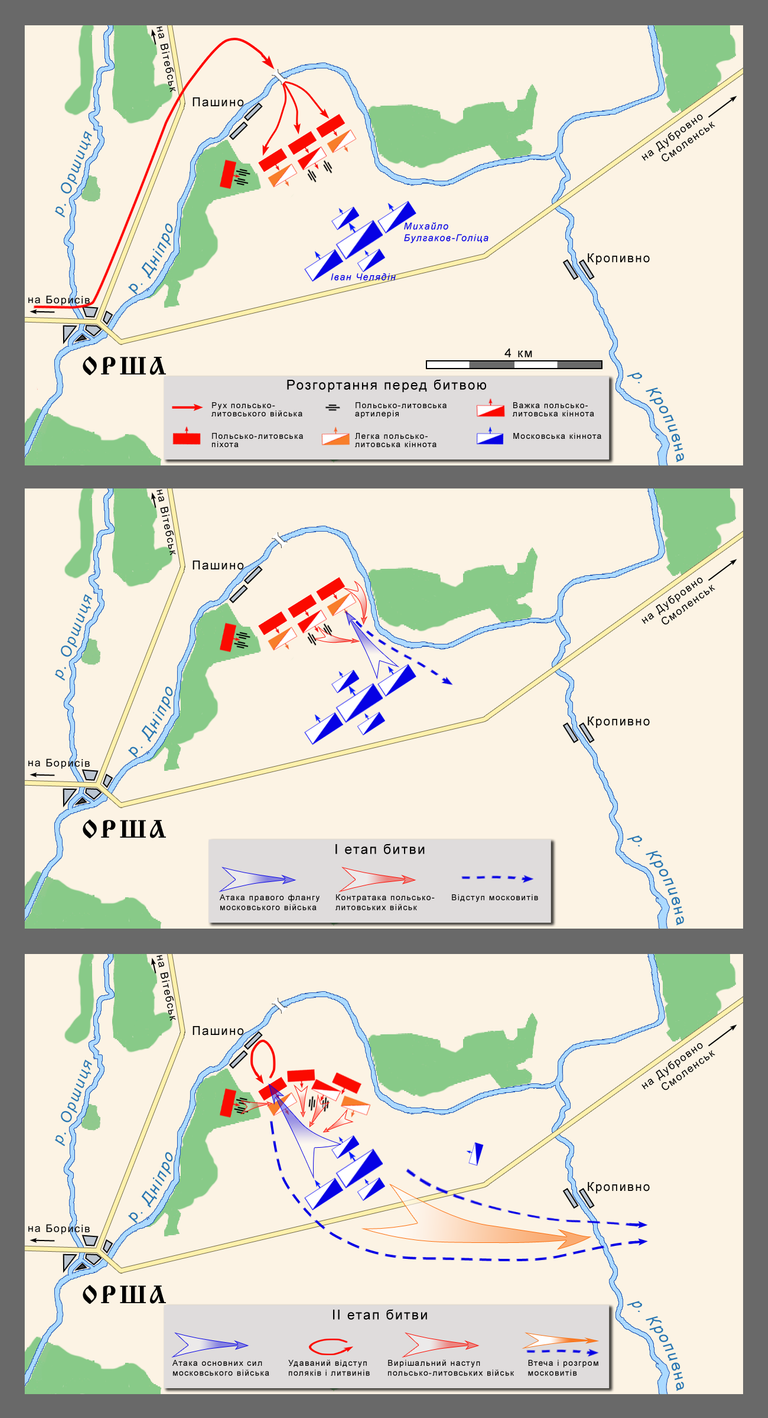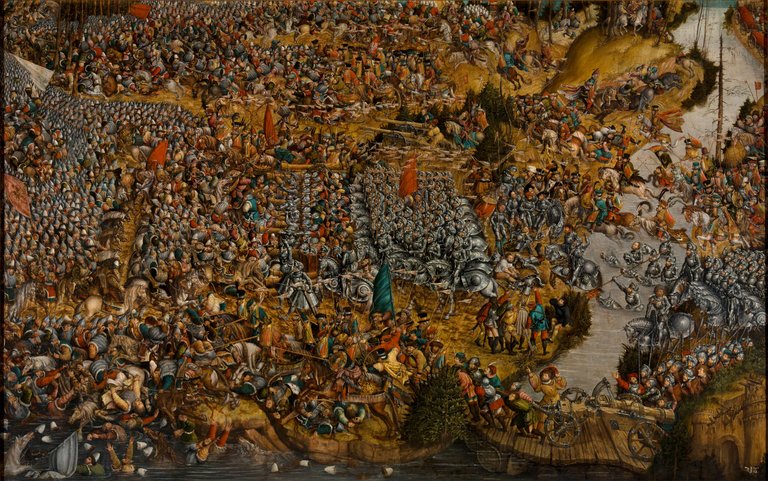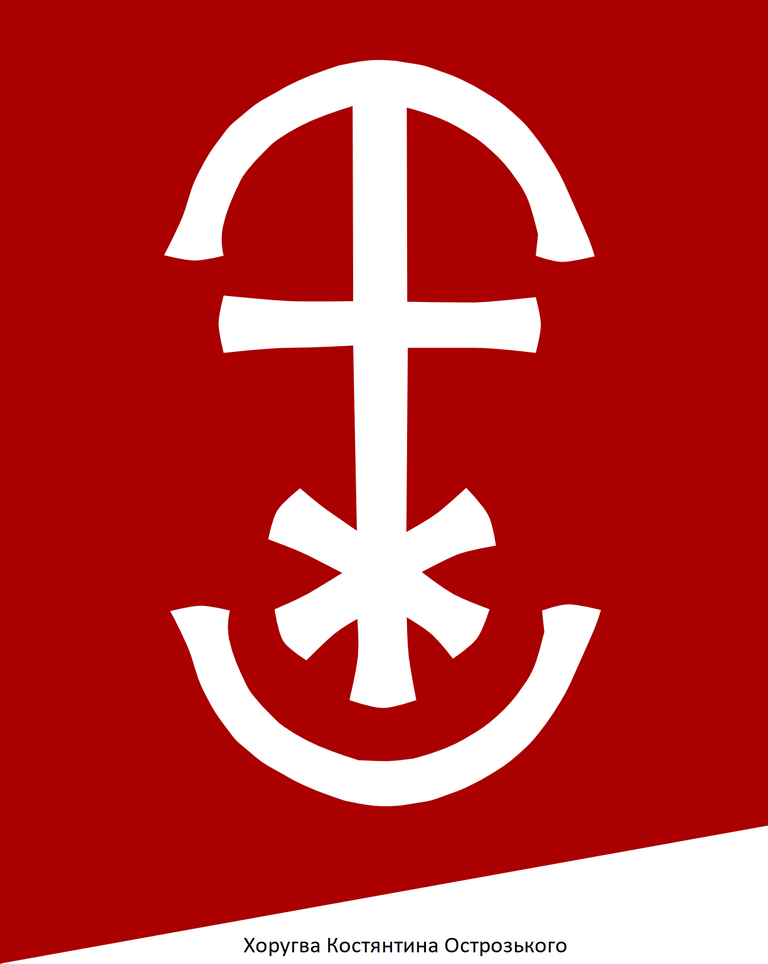8 вересня 1514 року відбулася битва під Оршею між 15-тисячним військом під командуванням князя Костянтина Івановича Острозького та московською армією на чолі з воєводою Іваном Челядніним.
Мене цікавлять історичні події, особливо ті, де росія отримує поразки в війнах. Я хочу провести власний аналіз дій росіян, причину початку війни та причину їхньої поразки. Таким чином я намагаюсь спрогнозувати , як довго буде тривати російсько – українська війна і, що може стати переломним моментом в поразці росії.
На початку XVI століття Московська держава висунула претензії на землі, розташовані на сучасних територіях України та Білорусі, які тоді входили до складу Великого князівства Литовського.
Влітку 1514 року московська армія після місячної облоги захопила Смоленськ і наприкінці серпня вийшла на лівий берег Дніпра неподалік Орші. Тим часом вдалося зібрати польсько-литовське військо, метою якого було відновити втрачені землі і фортеці Смоленщини, захоплені Москвою. Сили під командуванням великого гетьмана Литви князя Костянтина Івановича Острозького нарахували в цілому 16 тис. литовської легкої кавалерії, 14 тисяч польської кінноти (легкої та важкої), 3 тисячі найманої піхоти, 2,5 тисяч добровольців, а також королівську артилерію та інженерно-саперну роту.
Основна битва відбулася під Оршею. У ніч проти 8 вересня військо Великого князівства Литовського навело через Дніпро навпроти Орші наплавні мости на бочках і переправилося на лівий берег. Литовська армія складалася із власне литовських, білоруських, українських, сербських, татарських, польських, угорських та німецьких загонів. Цим об'єднаним військом командував п'ятдесятичотирилітній волинський князь Костянтин Острозький.
Росіяни пробували атакувати військо Острозького, намагаючись відрізати його від мостів, однак союзники відбили напад. К. І. Острозький очолював усі контратаки русько-литовської кінноти і бився, як простий вояк. Вершники Острозького, вдаваним відступом завели московську кінноту під залп своїх гармат, а потім її із засідки у прибережному лісі атакував резервний загін. Під натиском війська Острозького важка московська кіннота відступила на багнистий берег річки Кропивни між Оршею та Дубровною і там майже вся була знищена.
Російські війська зазнали поразки і відступили до Смоленська.
On September 8, 1514, a battle took place near Orsha between a 15,000-strong army under the command of Prince Konstantin Ivanovich Ostrozhsky and the Moscow army led by Voivode Ivan Chelyadnin.
I am interested in historical events, especially those where Russia is defeated in wars. I want to conduct my own analysis of the actions of the Russians, the reason for the start of the war and the reason for their defeat. In this way, I am trying to predict how long the Russian-Ukrainian war will last and what may be the turning point in Russia's defeat.
At the beginning of the 16th century, the Muscovite state made claims to the lands located in the modern territories of Ukraine and Belarus, which were then part of the Grand Duchy of Lithuania.
In the summer of 1514, the Muscovite army captured Smolensk after a month-long siege and at the end of August reached the left bank of the Dnieper near Orsha. In the meantime, it was possible to assemble a Polish-Lithuanian army, the purpose of which was to restore the lost lands and fortresses of Smolensk, captured by Moscow. The forces under the command of the Grand Hetman of Lithuania, Prince Konstantin Ivanovich Ostrosky, totaled 16,000 Lithuanian light cavalry, 14,000 Polish cavalry (light and heavy), 3,000 hired infantry, 2,500 volunteers, as well as royal artillery and an engineer-sapper company .
The main battle took place near Orsha. On the night of September 8, the troops of the Grand Duchy of Lithuania built floating bridges on barrels across the Dnieper opposite Orsha and crossed to the left bank. The Lithuanian army consisted of actual Lithuanian, Belarusian, Ukrainian, Serbian, Tatar, Polish, Hungarian and German units. This united army was commanded by the fifty-four-year-old Prince of Volyn, Konstantin Ostrozky.
The Russians tried to attack Ostrogsky's army, trying to cut it off from the bridges, but the allies repulsed the attack. K. I. Ostrozhkyi led all the counterattacks of the Russian-Lithuanian cavalry and fought like a simple soldier. The horsemen of Ostrozhsky, with a feigned retreat, brought the Moscow cavalry under the salvo of their guns, and then it was attacked from an ambush in the coastal forest by a reserve unit. Under the onslaught of Ostrozhsky's army, the heavy Moscow cavalry retreated to the muddy bank of the Kropyvna River between Orsha and Dubrovna, and there almost all of it was destroyed.
Russian troops were defeated and retreated to Smolensk.

Перемога під Оршею зробила К. І. Острозького відомим усій Європі. Його з тріумфом зустрічали у Варшаві та Вільнюсі, і на честь перемоги під Оршею він побудував у Вільні Свято-Троїцьку та Свято-Миколаївську церкви.
The victory at Orsha made K.I. Ostrozky famous throughout Europe. He was met with triumph in Warsaw and Vilnius, and in honor of the victory at Orsha, he built the Holy Trinity and St. Nicholas churches in Vilnius.
Про битву під Оршею розповідалося у чотирьох брошурах, виданих латиною та німецькою мовою. Папський легат у Польщі стверджував: “Князь Костянтин може бути названий найкращим воєначальником нашого часу, він 33 рази ставав переможцем на полі битви... в бою він не поступається хоробрістю Ромулу”. В подальшому князь ще неодноразово відзначався в битвах проти турків і татар.
У важкій битві військо князя Костянтина Острозького перемогло супротивника, що переважав, показавши високу взаємодію і злагодженість. Виснаженому у битві під Оршею війську не вдалося відбити Смоленськ, але небезпека вторгнення вглиб Литовсько-Руської держави та подальших територіальних втрат на користь Московської держави була ліквідована.
Я думаю, що одна з причин поразки росіян в цій битві криється в суперечках між князями Михайлом Голиця-Булгаковим та Іваном Челядніним, які командували Московським військом.
Використовуючи ці суперечності , Острозький нападав на них порізно, а ті із заздрості ще й видавали один одного.
The Battle of Orsha was told in four pamphlets published in Latin and German. The papal legate in Poland claimed: "Prince Constantine can be called the best military leader of our time, he won 33 times on the battlefield... in battle he is not inferior to Romulus in bravery." In the future, the prince distinguished himself more than once in battles against the Turks and Tatars.
In a tough battle, the army of Prince Konstantin Ostrozky defeated the superior opponent, showing high cooperation and coordination. The army, exhausted in the battle of Orsha, failed to recapture Smolensk, but the danger of invasion deep into the Lithuanian-Russian state and further territorial losses in favor of the Moscow state was eliminated.
I think that one of the reasons for the defeat of the Russians in this battle lies in the disputes between the princes Mikhail Golitsya-Bulgakov and Ivan Chelyadnin, who commanded the Moscow army.
Using these contradictions, Ostrozhsky attacked them separately, and they betrayed each other out of envy.





